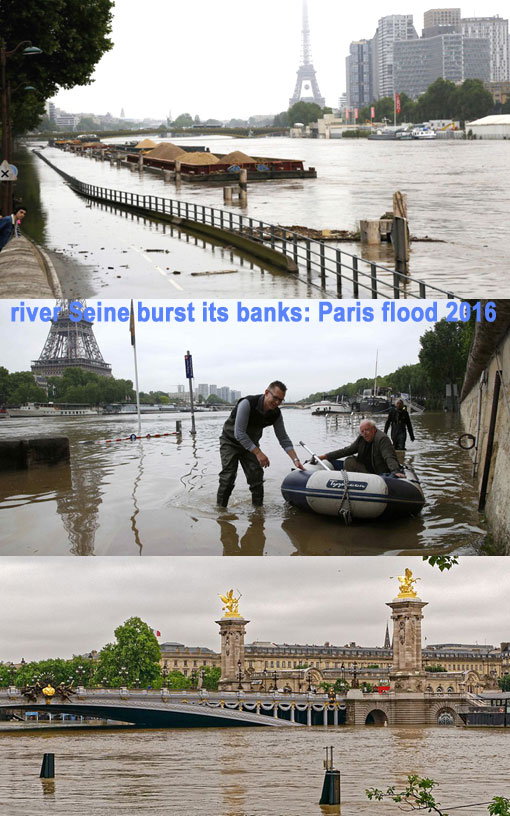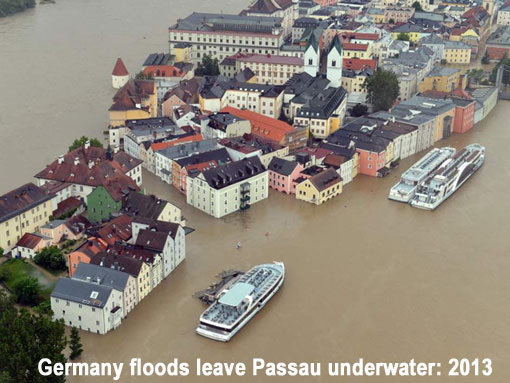You are hereBlogs / WcP.Observer's blog / Louvre and Musée d’Orsay closed amid Paris floods after days of non-stop heavy rain in Europe, river Seine burst its banks
Louvre and Musée d’Orsay closed amid Paris floods after days of non-stop heavy rain in Europe, river Seine burst its banks


*Update*

(quote)
heavy rain in Europe In late May and early June 2016 flooding began after several days of heavy rain in Europe, mostly Germany and France, but also Austria, Belgium, Romania, Moldova, Netherlands and the United Kingdom. Among others, the German states of Bavaria, Hesse, Rhineland-Palatinate, Baden-Württemberg, and North Rhine-Westphalia were affected. There was also severe flooding in France. Beginning at the river Neckar, also the Danube, Rhine, Seine and their tributaries were affected by high water and flooding along their banks.
Germany - The Baden-Württemberg village of Braunsbach was most heavily affected by the floods. After flash floods on 29 May 2016, small tributaries of the river Kocher flooded the streets of the village within minutes, and the roadways were buried under rocks, trees and car wrecks.
France - the river Seine burst its banks and one town was evacuated. Four people died in the floods. (Compare Flood level of the Seine in Paris 2016 against the flood height of 1910). Flooding in Paris was expected to peak at around 6.30 m above normal, higher than 6.18 m high seen in 1982, but below the 1955 flood level of 7.12 m, and the 1910 Paris flood which saw levels at 8.62 m above normal.
June 2, 2016 Louvre and Musée d’Orsay have shut their doors amid Paris floods
AFP Paris Updated: June 3, 2016 days of almost non-stop torrential rains Thousands evacuate for higher ground. France declared a state of "natural disaster" in some parts of the country. Nearly 22,000 homes in Paris and other regions are also without power after days of almost non-stop rain caused flooding in the country. The world’s most visited museum said it would shut its doors today to evacuate artworks from its basement storage, as the nearby river began to burst its banks following days of torrential rain.
Several towns in southern Germany have been devastated by flooding that has also seen rescuers in central France rowing lifeboats down streets turned into muddy rivers. There were also chaotic scenes in the German town of Simbach am Inn, where the force of the water swept away the entire stock of a sawmill, leaving huge stacks of splintered wood blocking roads. On one street, a car could be seen parked vertically against the wall of a house, pushed there by the floodwaters. Many other vehicles lay flipped over on roads blanketed by mud.
June 2, 2016 The Louvre and Orsay museums were shut Barges are moored together near the Eiffel Tower as high waters cover the banks of the Seine River in Paris, France, after days of almost non-stop rain caused flooding in the country. The River Seine in Paris is at its highest level for more than 30 years, with floods forcing closed parts of the metro systems and major landmarks. The Louvre and Orsay museums were shut while staff moved artworks to safety as flood levels climbed above 6m (18ft). Tens of thousands of people have been forced from their homes.
June 3, 2013 German town underwater after floods Swollen rivers gushed into the old section of Passau in southeast Germany on Monday, as water rose in the city to levels not seen in more than five centuries. The city was one of the worst hit by flooding that has spread across a large area of central Europe following heavy rainfall in recent days. At least eight people were reported to have died and nine were missing due to floods in Germany, Austria, Switzerland and the Czech Republic.
*Update June 10 2016* Louvre reopened the museum on June 8 The public can once again admire masterpieces such as the "Mona Lisa" with the reopening of the Louvre in Paris after flooding forced the museum to close.
Louvre officials reopened the museum on Wednesday, June 8, after an emergency closure last week. The rising of the River Seine that runs next to the building threatened to damage the museum’s collection, forcing officials to move 35,000 works from storage areas and lower floors to the upper levels. Visitors to the Louvre’s website were warned of an "exceptional closure" so it could "ensure the protection of the works located in flood zones."
Leonardo da Vinci’s "Mona Lisa" was not among the art that had to be relocated, as it already resides on the upper floor of the museum.
(unquote)
Photo courtesy REUTERS / Jacky Naegelen, Reuters, Wikipedia, NationalPost, and parkwestgallery / Pixabay



















I appreciate the knowledge on your site. Thanks for your time